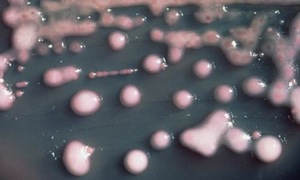
Australians have led an international team of researchers to decode the genes of a deadly superbug which kills up to half of those it infects, and which has wreaked havoc in Victorian hospitals.
The bacterium, Klebsiella pneumoniae (KP), is not easily treated with antibiotics. Last week, Victoria’s health department issued a health alert alert after a particularly drug-resistant strain, known as KPC, was found in two hospital patients who had died.
The KPC strain has caused significant problems in hospitals in the US and Europe for more than decade, and outbreaks in South America, Africa and Asia have caused serious infections there.
Because there are hundreds of strains of KP around the world, it has been difficult for researchers to figure out what components made them common in order to create an effective vaccine.
University of Melbourne researchers worked with hospitals and universities throughout the world to collect about 300 strains, or isolates, of the bacterium.
They then sequenced the genomes – in other words, determined the complete DNA sequence – of each of these 300 isolates to see which genetic traits were associated with the most deadly KP strains, including KPC, a co-author of the study, Professor Dick Strugnell, said.
“You can’t do it by looking at one or two isolates, but once you start looking at hundreds, like we did, you start to see more patterns,” Strugnell, from the university’s Doherty institute, said.
“It’s not until you do this international survey, with strains contributed from all over the world, that you come up with a foundation of components these bugs have in common, which you can then target with a vaccine.”
The research had taken 10 years, he said, but it was too soon to say when the latest discovery might result in a vaccine.
KP is spread through blood and urine, usually through person-to-person contact. Catheters and ventilators provide a way for the bacteria to enter the bloodstream, which is why KP is most commonly seen in hospitals.
Infections in people with compromised immune systems, in particular the sick, children or the elderly, can cause death.
But the study’s lead author, Dr Kathryn Holt, from the Bio21 Institute, said if more effective treatments or a vaccine were not developed, there was a risk the disease would evolve to become a significant threat to healthy people too.
“Almost any Klebsiella pneumoniae can cause an infection in someone who is already ill in hospital, but very few strains are virulent enough to affect a healthy person,” she said.
“So far we have been extremely lucky in that most of the antibiotic-resistant strains are not highly virulent to humans. Unfortunately, Klebsiella strains are very good at swapping around genes that encode antibiotic resistance, so it’s probably just a matter of time before we see this.”
Of the 300 strains researchers examined, every second one was new, Holt said.
“So that tells you there’s a lot of diversity out there and we don’t really have a handle on this at all.”
The researchers found KP had evolved a thick, sticky sugar “coat” which stopped it drying out. That contributed to the formation of biofilms of the bacteria, which are hard to remove from hospitals with traditional cleaning methods.
As a result infection control procedures such as hand-washing were vital to prevent an outbreak.
The findings were published in the Proceedings of the National Academy of Sciences on Tuesday.
